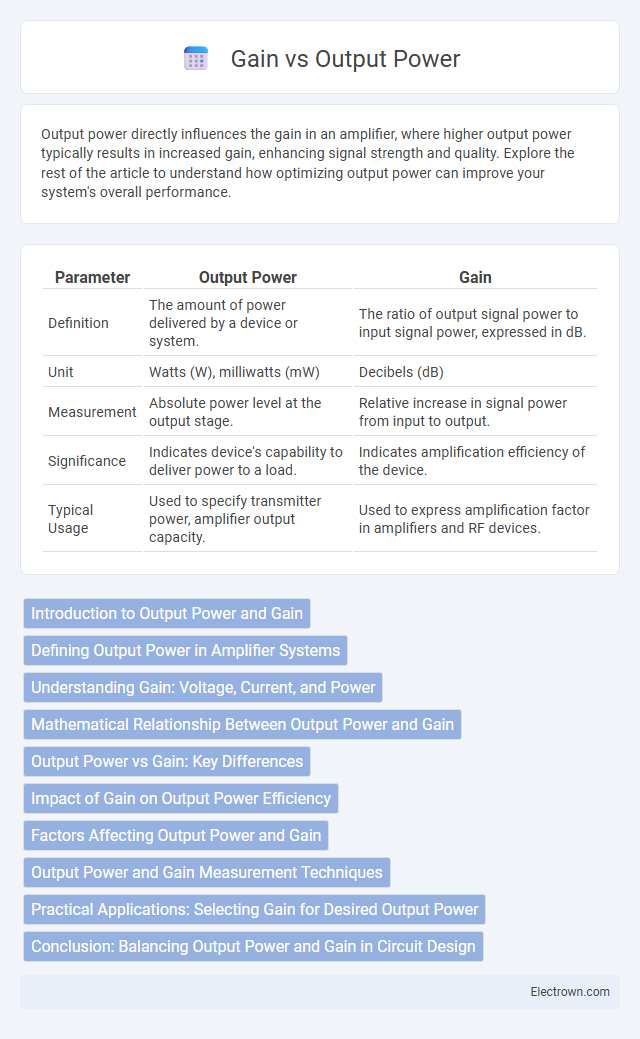Output power directly influences the gain in an amplifier, where higher output power typically results in increased gain, enhancing signal strength and quality. Explore the rest of the article to understand how optimizing output power can improve your system's overall performance.
Table of Comparison
| Parameter | Output Power | Gain |
|---|---|---|
| Definition | The amount of power delivered by a device or system. | The ratio of output signal power to input signal power, expressed in dB. |
| Unit | Watts (W), milliwatts (mW) | Decibels (dB) |
| Measurement | Absolute power level at the output stage. | Relative increase in signal power from input to output. |
| Significance | Indicates device's capability to deliver power to a load. | Indicates amplification efficiency of the device. |
| Typical Usage | Used to specify transmitter power, amplifier output capacity. | Used to express amplification factor in amplifiers and RF devices. |
Introduction to Output Power and Gain
Output power measures the amount of energy delivered by an amplifier or device, usually expressed in watts, indicating its capacity to drive a load. Gain represents the ratio of output signal strength to input signal strength, often measured in decibels (dB), reflecting the amplifier's ability to boost signals. Understanding the relationship between output power and gain is crucial for optimizing the performance and efficiency of your electronic systems.
Defining Output Power in Amplifier Systems
Output power in amplifier systems refers to the amount of electrical power delivered to the load, typically measured in watts (W). It directly impacts the strength and quality of the amplified signal, determining how effectively the system drives speakers or other devices. Your amplifier's output power must be matched with the gain to ensure optimal performance without distortion or damage.
Understanding Gain: Voltage, Current, and Power
Gain represents the ratio of output to input in electrical circuits, measured as voltage gain, current gain, or power gain depending on the parameter amplified. Voltage gain is the ratio of output voltage to input voltage, while current gain compares output current to input current. Power gain combines both factors, indicating how much the output power increases relative to the input power, critical in evaluating amplifier performance and efficiency.
Mathematical Relationship Between Output Power and Gain
The output power (P_out) of an amplifier is related to the gain (G) by the equation P_out = G x P_in, where P_in is the input power. Gain is typically expressed in decibels (dB) using the formula G_dB = 10 log10(P_out / P_in). This logarithmic relationship enables precise calculation of output power from gain values and input power levels in communication and signal processing systems.
Output Power vs Gain: Key Differences
Output power measures the total energy a device or amplifier can deliver to a load, while gain represents the ratio of output signal strength to input signal strength, often expressed in decibels (dB). Understanding the key differences between output power and gain is essential for optimizing amplifier performance in communication systems and electronic circuits. Your choice depends on whether you need to maximize signal amplification (gain) or deliver sufficient power to the load (output power).
Impact of Gain on Output Power Efficiency
Higher gain amplifies the input signal, increasing output power, but excessive gain can reduce efficiency due to power dissipation and distortion. Optimizing gain balances output power and efficiency, ensuring maximum signal amplification without unnecessary energy loss. Your system's performance depends on selecting the appropriate gain level to maintain efficient power usage while achieving desired output strength.
Factors Affecting Output Power and Gain
Output power and gain in amplifiers are primarily influenced by factors such as supply voltage, transistor characteristics, and load impedance. Thermal stability and signal frequency also play critical roles in determining the efficiency and linearity of the gain, impacting your device's overall performance. Proper matching of these elements ensures optimal output power while maintaining desired gain levels.
Output Power and Gain Measurement Techniques
Output power and gain measurement techniques are essential in evaluating amplifier performance, utilizing instruments like spectrum analyzers, power meters, and network analyzers for accurate results. Techniques such as the two-tone test for gain compression and the use of calibrated signal sources help ensure precision in gain and output power measurements. Your choice of measurement setup depends on factors like frequency range, signal type, and required accuracy to optimize device characterization.
Practical Applications: Selecting Gain for Desired Output Power
Selecting the appropriate gain is essential for achieving the desired output power in practical applications such as radio frequency amplifiers, audio systems, and wireless communication devices. Engineers must balance gain with factors like signal distortion, noise figure, and power efficiency to optimize system performance. Precise gain control ensures that output power meets regulatory limits and design specifications while maintaining signal integrity.
Conclusion: Balancing Output Power and Gain in Circuit Design
Balancing output power and gain in circuit design is essential for optimizing overall performance and efficiency. High output power often requires careful management of gain to prevent distortion and maintain signal integrity. Prioritizing this balance ensures your circuit achieves the desired amplification without compromising stability or power consumption.
Output Power vs Gain Infographic

 electrown.com
electrown.com